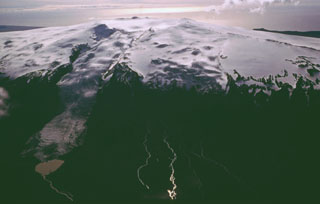Report on Eyjafjallajokull (Iceland) — 31 March-6 April 2010
Smithsonian Institution / US Geological Survey
Weekly Volcanic Activity Report, 31 March-6 April 2010
Managing Editor: Sally Sennert.
Please cite this report as:
Global Volcanism Program, 2010. Report on Eyjafjallajokull (Iceland) (Sennert, S, ed.). Weekly Volcanic Activity Report, 31 March-6 April 2010. Smithsonian Institution and US Geological Survey.
Eyjafjallajokull
Iceland
63.633°N, 19.633°W; summit elev. 1651 m
All times are local (unless otherwise noted)
The Icelandic Met Office reported that around 1900 on 31 March a new fissure at Eyjafjöll opened NE of the first fissure that began erupting on 20 March. Activity from the second fissure was not preceded by detectable seismicity. According to a news article, the fissure was about 300 m long, and about 200 m away from the first fissure. At the time of reporting by the Icelandic Met Office on 5 April, lava fountains had remained active from both fissures. Lava mostly accumulated near the new vent but some lava flows had entered the Hruná and Hvanná gullies. News outlets reported that two people had died during the journey back from seeing the eruption. The police estimated that 25,000 people had visited the site since the eruption began.
Geological Summary. Eyjafjallajökull (also known as Eyjafjöll) is located west of Katla volcano. It consists of an elongated ice-covered stratovolcano with a 2.5-km-wide summit caldera. Fissure-fed lava flows occur on both the E and W flanks, but are more prominent on the western side. Although the volcano has erupted during historical time, it has been less active than other volcanoes of Iceland's eastern volcanic zone, and relatively few Holocene lava flows are known. An intrusion beneath the S flank from July-December 1999 was accompanied by increased seismic activity. The last historical activity prior to an eruption in 2010 produced intermediate-to-silicic tephra from the central caldera during December 1821 to January 1823.
Sources: Morgunbladid News, Iceland Review, Icelandic Meteorological Office (IMO), Iceland Review

